|
 Secure Site
Secure Site
|
 |
Archive for the 'Zen Timers' Category
 Meditation Practice, Stillness of Being For a formal practice to cultivate equanimity, begin with some calming breaths or a mantra meditation. Once you feel calm, reflect on your desire for happiness and freedom from suffering, both for yourself and for others. Contemplate your desire to serve the needs of others and to be compassionately engaged in the world. Acknowledge both the joy and the suffering that exist throughout the world—the good deeds and the evil ones. As you continue to breathe into your heart’s center, acknowledge the necessity of balancing your desire to make positive change in the world with the reality that you cannot control the actions of others.
Bring to mind the image of someone for whom you have no strong feelings one way or the other. With this person in your mind’s eye, repeat the following phrases to yourself, coordinating with the outbreath if you like:
- All beings like yourself are responsible for their own actions.
- Suffering or happiness is created through one’s relationship to experience, not by experience itself.
- Although I wish only the best for you, I know that your happiness or unhappiness depends on your actions, not on my wishes for you.
- May you not be caught in reactivity.
Feel free to use other similar, appropriate phrases of your own devising. After a few minutes, shift your attention to your benefactors, including teachers, friends, family and the unseen workers who keep the societal infrastructure working. Silently repeat the phrases to yourself as you contemplate these benefactors.
After several minutes, begin to reflect on your loved ones, directing the phrases to them, followed by the difficult people in your life. While feeling kindness, compassion, and joy for those we love comes more easily than it does for those with whom we have difficulty, it is often the opposite with equanimity. It’s a lot easier to accept that those we dislike are responsible for their own happiness than it is for those we care for deeply, because we feel more attachment to them. Whatever your experience, simply note any reactivity and see if you can be equanimous with your reactivity! Broaden your reach after a few minutes to include all beings everywhere throughout the world, and then finally contemplate equanimity in regard to yourself, noticing how taking responsibility for your own happiness and unhappiness can feel the hardest of all.
- All beings, including myself, are responsible for their own actions.
- Suffering or happiness is created through one’s relationship to experience, not by experience itself.
- Although I wish only the best for myself, I know that my happiness or unhappiness depends on my actions, not my wishes for myself.
- May I not be caught in reactivity.
adapted from Yoga Journal by Frank Boccio
Frank Jude Boccio is a teacher of yoga and Zen Buddhism and the author of Mindfulness Yoga. Find him at mindfulnessyoga.net.
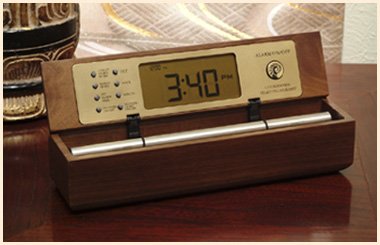 Meditation Timer for Your Meditation Practice The Walnut Digital Zen Clock’s long-resonating Tibetan bell-like chime makes waking up and meditating a beautiful experience – its progressive chimes begin your day with grace. When the clock’s alarm is triggered, the acoustic chime bar is struck just once … 3-1/2 minutes later it strikes again … chime strikes become more frequent over 10 minutes … eventually striking every 5 seconds until shut off. As they become more frequent, the gentle chimes will always wake you up or bring you out of your meditation. Your body really doesn’t need to be awakened harshly, with a Zen Clock you’re awakened more gradually and thus more naturally. Unlike artificial recorded sounds coming out of a tiny speaker in a plastic box, natural acoustic sounds transform your bedroom or office environment.
The Digital Zen Clock also serves as a countdown and interval timer for yoga, meditation, bodywork, etc.; and it can also be set to chime on the hour as a tool for “mindfulness.”
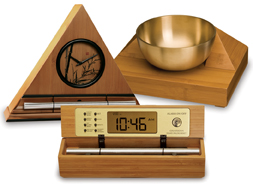 Find the Entire Family of Meditation Timer and Gongs at Now & Zen's Store in Boulder Now & Zen’s Meditation Timer Store
1638 Pearl Street
Boulder, CO 80302
(800) 779-6383
Posted in intention, Meditation Timers, Meditation Tools, mindfulness practice, Well-being, Zen Timers
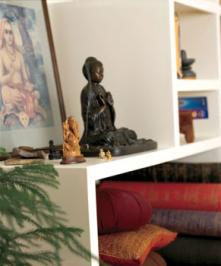 creating a meditation space in your home • It doesn’t really matter where your meditation space is located in your house, although Rodney Yee says the Balinese consider the northeast corner culturally and religiously auspicious. Tias Little likes the southeast corner because it captures morning light for early meditation. Basically, says Yee, pick a space where you feel relaxed and comfortable. “I think everybody has a special little place where they go to be quiet—just like a cat that searches until it finds the right spot to sleep.”
• You can think big thoughts in any size space. Your meditation area can be as expansive as Richard Freeman’s, a room “at the very top of the house, encompassed by a big maple tree,” or simply a spare closet or an empty corner. Rainbeau Mars likes a window for fresh air as long as it’s not distracting, but Little says a semi-enclosed space can give a “really spectacular feeling, like a little womb.” You might consider creating a six- or seven-foot-square adobe “cell” addition to your house or yard.
 meditation space • “Anyone can use [a meditation space], but only for meditation,” Deepak Chopra says. Freeman says to minimize distraction, you should choose a location that’s as isolated as possible from the traffic flow in your house, and it shouldn’t be in an area where you’re more tempted to sleep than meditate. If you share your space, each person should have his or her own chair, cushion, zabuton mat, or zafu pillow, “something that sanctifies this is my space,” Mars says. Sit on it only when you meditate. That helps create a ritual conducive to meditation, Judith Hanson Lasater says. It is nice to have a special Zen Meditation Timer on a table beside your the chair or cushion that you meditate on. This way you can easily reach the meditation timer to turn it off when it chimes and then you can continue to sit in peace until ready to move.
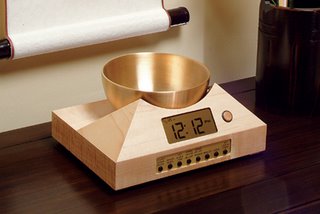 Zen Timepiece, a brass singing bowl clock and timer • Tatami mats or bare wood floors are a better, cleaner option than rugs or carpets, and they create a more spacious feeling, Little says.
• An altar is a good idea. “When you set it up, the space begins to get that special feeling,” Yee says. An altar makes it clear the space is reserved for meditation and serves as a repository for your sacred objects and decorations. It needn’t be elaborate: Little has seen window sills used as altars. Yee’s altar is a small, low table covered with a Balinese cloth; Freeman’s is a stone slab.
• If you do yoga in your meditation space, store props such as mats, blocks, and straps in a chest. Leaving them out creates distracting clutter.
• Avoid bright overhead lighting, or use a dimmer switch. Lamps or sconces are best because they combine illumination with warmth.
• Include a timer. Meditation is all about discipline and consistency, and meditating a set amount of time each day can help achieve that, Lasater says. The Zen Timepiece chimes gently at the end of one’s meditation without startling one back to the here and now.
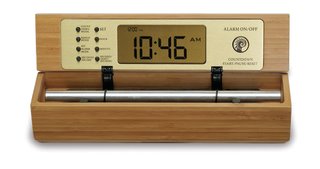 Bamboo Zen Meditation Timer • Even experts disagree on how to decorate your space. Most are minimalists. “It needs to be elegant in its simplicity and with very little clutter,” Chopra says. His recommended decorations include candles, books, and symbolic representations of archetypal figures such as gods, goddesses, angels, flowers, incense, and pastel colors. “You should not include anything that symbolically represents violence,” he adds. Yet not everyone finds minimalism calming, points out Freeman. “Some people display every saint they’ve ever heard of; some people may have only one. Others might light a candle; others prefer nothing. It’s whatever makes you want to sit there and do nothing.”
adapted from Natural Home Magazine, Jan/Feb 2005 by Vicky Uhland
Posted in Bamboo Chime Clocks, Japanese Inspired Zen Clocks, Meditation Timers, Meditation Tools, mindfulness practice, Well-being, Zen Timers
 Try a Listen Meditation as a Mindfulness Practice Listening Meditation
Instructor Sally Kempton is a spiritual guide who teaches yoga and meditation at her Carmel, Calif.-based Awakened Heart Meditation (sallykempton.com). She authored The Heart of Meditation under her monastic name Swami Durgananda.
What is it? While many meditation techniques require solitude and silence, this one has you engage with the sounds all around you; it invites you to work with and use the noise instead of fighting it. Listening meditation also encourages you to harmonize with your surroundings, and, by extension, the universe. The intent is to experience sound as vibration, rather than information. The listening practice is a way of interacting with the environment that allows you to take in the whole energy of the present moment, says Kempton.
What’s it good for? Especially adaptable and portable, listening meditation can be practiced in crowded, noisy situationson a bus, at the office that would be hard on other styles. (Kempton once led a listening meditation workshop in the middle of a busy Whole Foods store!) People with particularly chattering minds may need to couple this practice with a mantra or breathing meditation. However, many people welcome the chance to focus outward rather than inward and find that listening meditation is one of the easier techniques to undertake. You’ll come away from it feeling refreshed, expanded, and at ease with your environment, declares Kempton.
How long does it take? Try for five minutes at first, then add a minute or two until you can do it for 15 or 20 minutes at a time. Set your Chime Meditation Timer by Now & Zen for five minutes and then increase as you get better at this practice.
How Do I Do It?
1. Set your Meditation Chime Timer for 5 minutes (increase the minutes as you improve). Sit in a comfortable position and close (or half close) your eyes.
2. To get centered and quiet the mind, first bring your awareness to your breath, noticing but not trying to change it.
3. Now open your ears and bring your awareness to the sounds around you. The goal is to listen to the whole range of sounds, without favoring one over another and without identifying them. Hear the quiet sounds and the silences as well as the dominant sounds.
4. When you find yourself identifying sounds (there’s a fire engine; thats the cat scratching the rug), gently redirect your attention from listening to a specific noise back to hearing the whole spectrum of sounds.
5. To end, slowly open your eyes, stand, and carry this heightened awareness with you for as long as you can.
Tip: Do a one-minute mini-listening meditation while standing in line or sitting at your desk, or anytime you feel frazzled: Close your eyes, breathe, and listen to the sounds around you. Like the practice of counting to 10 when you’re in the heat of an argument, this will help you pause, center, and regroup.
 Zen Meditation Timers, The Digital Zen Alarm Clock in Solid Walnut adapted from Natural Health Magazine
Now & Zen’s Chime Time Store
1638 Pearl Street
Boulder, CO 80302
(800) 779-6383
Posted in Bamboo Chime Clocks, Chime Alarm Clocks, intention, Meditation Timers, Meditation Tools, mindfulness practice, Well-being, Zen Timers
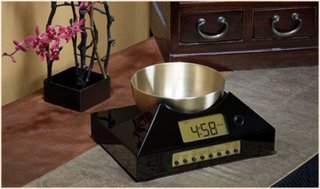 Zen Timepiece Black with Long-resonating Singing Bowl
Bells, gongs, and chimes are used prominently in both Eastern and Western spiritual traditions. The use of metal alloy bowls for devotional purposes can be traced back to the beginnings of metallurgy in China prior to 1,000 B.C. The bowl that comes with your Zen Timepiece is modeled after a Japanese “rin gong,” or Keisu, that is periodically struck with a stick to punctuate sutra-reading in Buddhist temples.
 Singing Bowl Alarm Clocks and Chime Alarm Clocks Now & Zen Headquarter Store
1638 Pearl St.
Boulder, CO 80302
(800) 779-6383
Posted in Bamboo Chime Clocks, Zen Alarm Clock, Zen Timers
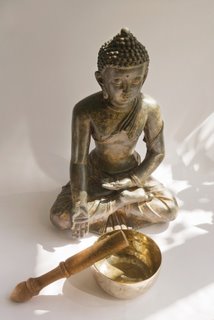 Carved Wooden Thai Buddha with Singing Bowl The Himalayan peoples have been using metal bowls in their rituals and as offerings to Deities since at least 560 B.C. These hand-hammered Himalayan alloy bowls have come to be known as “Tibetan Singing Bowls”
because of the unique way they are sounded by rubbing a mallet over the rim so as to produce harmonic resonances and overtones. Although the bowl that comes with your Zen Timepiece is not technically a Tibetan Singing Bowl, it will produce harmonic effects if a mallet or striking stick is rubbed around its edge in a circular motion.
The Himalayan peoples have been using metal bowls in their rituals and as offerings to Deities since at least 560 B.C. These hand-hammered Himalayan alloy bowls have come to be known as “Tibetan Singing Bowls” because of the unique way they are sounded by rubbing a mallet over the rim so as to produce harmonic resonances and overtones. Although the bowl that comes with your Zen Timepiece is not technically a Tibetan Singing Bowl, it will produce harmonic effects if a mallet or striking stick is rubbed around its edge in a circular motion.
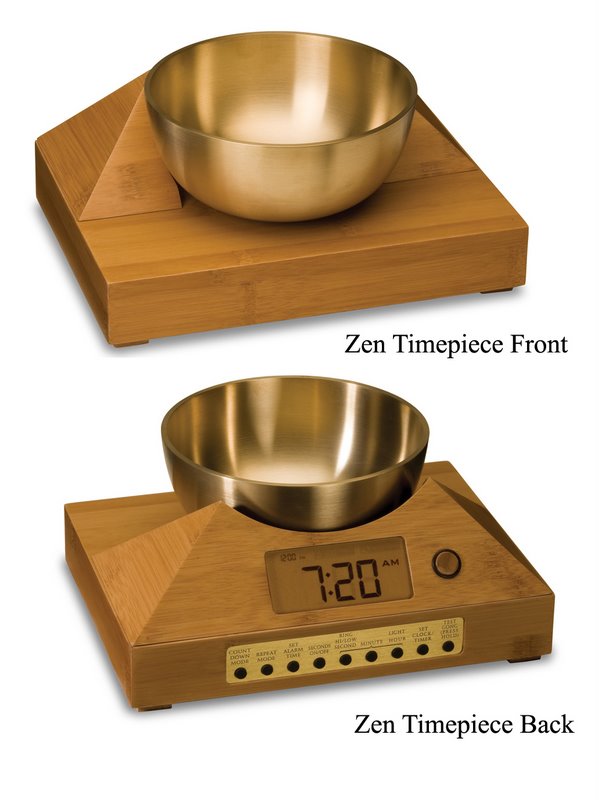 Singing Bowl Alarm Clocks for a Gentle Awakening Now & Zen
1638 Pearl St.
Boulder, CO 80302
(800) 779-6383
Posted in Bamboo Chime Clocks, Zen Alarm Clock, Zen Timers
 meditation Science has proven that meditating actually restructures your brain and can train it to concentrate, feel greater compassion, cope with stress, and more. Read the latest research and put it into practice.
Yoga citta vritti nirodhah. Yoga is the ending of disturbances of the mind. (Yoga Sutra, I.2)
Nothing is quite as satisfying as a yoga practice that’s filled with movement. Whether you prefer an intense and sweaty vinyasa practice, a gentle but deliberate Viniyoga practice, or something in between, all systems of hatha yoga provide a contented afterglow for the same reason: You sync your movement with your breath. When you do, your mind stops its obsessive churning and begins to slow down. Your attention turns from your endless to-do list toward the rhythm of your breath, and you feel more peaceful than you did before you began your practice.
For many of us, accessing that same settled, contented state is more difficult to do in meditation. It’s not easy to watch the mind reveal its worries, its self-criticism, or its old memories. Meditation requires patience and—even more challenging for most Westerners—time. So, why would you put yourself through the struggle?
Quite simply, meditation can profoundly alter your experience of life. Thousands of years ago the sage Patanjali, who compiled the Yoga Sutra, and the Buddha both promised that meditation could eliminate the suffering caused by an untamed mind. They taught their students to cultivate focused attention, compassion, and joy. And they believed that it was possible to change one’s mental powers and emotional patterns by regularly experiencing meditative states. Those are hefty promises.
But these days, you don’t have to take their word for it. Western scien-tists are testing the wisdom of the masters, using new technology that allows researchers to study how meditation in-fluences the brain.
The current findings are exciting enough to encourage even the most resistant yogis to sit down on the cushion: They suggest that meditation—even in small doses—can profoundly influence your experience of the world by remodeling the physical structure of your brain.
Our Zen Timepiece’s acoustic 6-inch brass bowl-gong clock is the world’s ultimate alarm clock, practice timer, and “mindfulness bell.”
It fills your environment with beautifully complex tones whenever it strikes. In the morning, its exquisite sounds summon your consciousness into awakening with a series of subtle gongs that provide an elegant beginning to your day. Once you experience the Zen Timepiece’s progressive awakening, you’ll never want to wake up any other way. It also serves as the perfect meditation timer.
adapted from Yoga Journal, By Kelly McGonigal
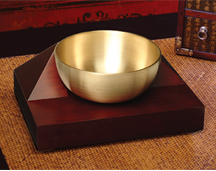 Meditation Timers with Tibetan-Singing Bowls Now & Zen
1638 Pearl Street
Boulder, CO 80302
(800) 779-6383
Posted in Bamboo Chime Clocks, Chime Alarm Clocks, intention, Meditation Timers, Meditation Tools, mindfulness practice, Now & Zen Alarm Clocks, Zen Timers
 Meditation - Utamaro Woman I have always been intrigued by the idea of meditation. I would love to be able to sit quietly, relax and let my mind wander into a trancelike rest, all at the same time.
There are reported medical benefits to regular meditation too: you can bring down your heart rate and blood pressure. Meditation has been shown to help insomniacs sleep, nervous Nellies relax and those withchronic pain breathe more easily.
Meditation sounds like a perfect dream, actually, but who has time for that? As a television producer, I would say my daily list of things to do can run longer than a pilgrimage to the Ganges. Would it be worth adding meditation to my to-do list? I needed to be convinced.
So I went to Avery Fisher Hall in Manhattan for a group meditation led by Sri Sri Ravi Shankar, a spiritual leader and founder of The Art of Living Foundation. “The Guru,” as he is called, traveled from southern India to kick off the “I Meditate NY” campaign, designed to introduce stressed-out New Yorkers to the powers of the ancient practice of meditation. Gathered in the hall normally reserved for plays and operas were nearly 2,700 people ready to follow the spiritual teachings of the master on stage.
The preparation began with ancient Sanskrit chants from the folk group Bakti and soulful vocals from the Grammy-nominated singer Chandrika Tandon. But before long The Guru took center stage, sitting in the lotus position on a regal loveseat.
With a creeping smile on his face, he began to explain the three platinum rules of meditation. The first, he said, was to say to oneself, “For the next 10 minutes, I want nothing.” Sounded simple enough, but the truth is I did want something. I was a little hungry, even though I had a pretty big cheeseburger a few hours earlier. It even had all sorts of extras on it. My mind started to wander: Why was I hungry when I just had a big meal? Maybe it wasn’t as big as I thought? Oh man, that means that cheeseburger must have clearly been full of empty calories.
But The Guru had already moved on to platinum rule number two: “For the next 10 minutes, I do nothing.” Just then, my foot started to itch. I reached down to scratch it immediately, figuring the clock hadn’t yet started.
Rule three: “For the next ten minutes, I am nothing.” Now he was on to something. I liked that idea. It made me feel as if I had permission to float away, let my spirit drift into oblivion, all the while surrounded by thousands of people.
 Meditation - Choose a Gong Meditation Timer Sounds of Silence
The group was full of Om’s and ready to sink into silence… or so we thought. Just then, The Guru reached into the pocket of his caftan for hiscellphone. The crowd burst into laughter — no doubt, this was a 21st-century guru. He promised it was only to time our imminent meditation, which he has said would last about 10 minutes.
Now we were on our way. He asked everyone to keep still and be quiet. If you didn’t think you could do so, it was now time for you to leave. He said nobody should leave in the middle of the journey, as that would not be fair to others around them. Parents with children were asked to leave now. It was time to begin.
The room fell silent, but not silent enough. There were coughs, bodily noises, feet sliding, and yes, a cell phone. I thought, it’s going to be tough to concentrate on doing nothing. The coughs seemed ceaseless. I wondered, well, we are heading into allergy season, is that why there are so many coughs? Or is this just how people always are? It isn’t often I’m in a room with 2,700 people.
But then something happened. I don’t really know what happened, because it’s as if I wasn’t there when it occurred. I mean, I was there, but I was nothing more than just there. Sitting. Breathing. Not hearing coughs. Not hearing feet shuffling. Not even hearing silence. I was awake. I was conscious. It wasn’t that hard. I was peaceful. I was meditating.
There we were. An auditorium full of silent people, together, effortless, releasing our minds from daily stress, buried in peace, meditating.
Meditation: Struggling to Do Nothing
And then it was over. The Guru woke us up — and then he gave us a jolt. He told us in his gentle meandering voice that we had been in this “amusement paradise” for 22 minutes. Not 10 minutes as he had suggested, but more than double that. The entire room gasped. We had disappeared for nearly the length of an evening news broadcast.
And, even though it felt counterintuitive to do something so seemingly solitary with so many others, it actually now made perfect sense. Later, The Guru told me, “Group meditations help in creating a positive energy in the atmosphere.” Meditation was all about vibrations, he said. Just as we “catch anger” from angry people around us, we “catch” positive energy from positive people around us. The room was surely full of positivity.
 meditation timers with gongs So there you have it. A frazzled New Yorker with a Ganges-long list of to-dos may have just peacefully and willingly made her list longer.
Use our unique “Zen Clock” which functions as a Yoga & Meditation Timer. It features a long-resonating acoustic chime that brings your meditation or yoga session to a gradual close, preserving the environment of stillness while also acting as an effective time signal. Our Yoga Timer & Clock can be programmed to chime at the end of the meditation or yoga session or periodically throughout the session as a kind of sonic yantra. The beauty and functionality of the Zen Clock/Timer makes it a meditation tool that can actually help you “make time” for meditation in your life. Bring yourself back to balance.
It’s exquisite sounds summon your consciousness out of your meditative state with a series of subtle gongs. Once you experience the Zen Timepiece’s progressive tones, you’ll never want to meditate any other way. It serves as the perfect meditation timer. Available in 5 wood styles, including bamboo.
adapted from WorldNewsReport.com by Gitka Ahuja
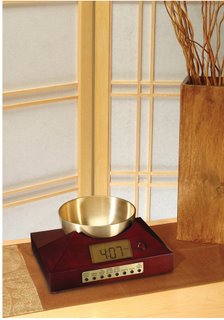 Gong Meditation Timers for Your Stillness Practice Now & Zen – The Gong Meditation Timer Store
1638 Pearl Street
Boulder, CO 80302
(800) 779-6383
Posted in Well-being, Yoga Timer, Yoga Timers by Now & Zen, Zen Alarm Clock, Zen Timepiece by Now & Zen, Zen Timers
 be calm for your health High blood pressure is not something you’d expect to see in kids, but the incidence has risen dramatically in the last few years along with their obesity rates. And there’s plenty of reason to be alarmed, since the condition can lead to heart disease later in life.
Luckily, there’s an easy way to treat it that doesn’t involve nagging kids to get up and exercise (not that being active is a bad thing, of course). Meditation, a proven blood pressure-reducer for adults, turns out to be useful for hypertensive children as well.
In a recent study at a middle school in Augusta, Georgia, 73 11- and 12-year olds were randomly assigned to either a meditation group or a health class where they learned about exercise and nutrition. After three months, the meditators, who practiced for 20 minutes twice a day, saw a significant drop in their blood pressure. The other group got no such benefit.
“If they keep it up, the meditators could substantially reduce their risk of dying from heart disease or stroke,” says Vernon Barnes, coauthor of the study. Some kids also got relief from headaches and asthma attacks, he adds.
A safe, and free, solution to some serious health problems: What more could you ask for?
adapted from Natural Solutions Magazine
Our Zen Timepiece’s acoustic 6-inch brass bowl-gong timer & clock is the world’s ultimate alarm clock, practice timer, and “mindfulness bell.”
 Zen Timepiece, a natural sounding timer with bowl/gong Now & Zen’s Clock and Meditation Timer Store
1638 Pearl Street
Boulder, CO 80302
(800) 779-6383
Posted in intention, Meditation Timers, Meditation Tools, Well-being, Zen Timers
 It's okay to nap during the day - Choose a gentle wake up - a Chime Zen Alarm Clock Have you ever felt an overpowering urge to find privacy and a bed for a midday “quickie?” Don’t feel guilty about that. It’s just your body telling you what it needs — sleep!
It’s unfortunate that most daily schedules can’t accommodate that need. Quickie naps are good for you. During the nap period of seeming inactivity, you do not simply “turn off;” complex reparative processes occur in your body. While the exact physiologic mechanisms responsible for the benefits of napping are not yet well understood, its positive outcomes have been confirmed in studies: they include improvements in mood, alertness, memory, performance and decision-making ability.
Let’s start with the best time for a nap: afternoon. An afternoon nap does not disrupt normal circadian (meaning: about a day) rhythms, whereas a morning or evening nap can — making it harder for you to return to your usual sleep routine that night. Your body probably already tells you this: circadian changes in your hormones and temperature are likely to make afternoon a naturally sleepy time for you. These cyclical patterns help explain why simply tacking more minutes or hours of sleep onto your nocturnal sleep time won’t necessarily prevent afternoon sleepiness. No matter how much you sleep at night, the afternoon urge will probably hit you.
How long should you nap? About 20 minutes. Anything much longer can backfire. You know that prolonged groggy feeling you sometimes feel after a nap? It’s called sleep inertia; you may have experienced it if you napped too long. Sleep inertia can take anywhere from 15 minutes to 4 hours to wear off. During this period, studies have shown impairments in mood, alertness, memory, performance and decision-making abilities. The likelihood of developing sleep inertia depends on several factors, one of which is the sleep stage from which you awaken. In a June, 2006 study in Sleep (the peer-reviewed publication of the Associated Professional Sleep Societies), investigators demonstrated the positive cognitive effects following 10- and 20-minute naps, but also the negative effects of sleep inertia following a 30-minute nap. The 30-minute timing coincides with the normal onset of deep sleep (also called slow-wave sleep). Limiting your nap time will help prevent entry into deep-sleep stages — avoiding sleep inertia while minimizing disruptions to your normal nocturnal sleep.
 Choose the most natural wake up -- a gentle Zen Alarm Clock with Soothing Chimes Keep in mind quickie-napping can’t compensate for significant sleep debt. While the increasing demands of our lifestyles may not reflect it, a wealth of research has verified that most adults require an average of 7 to 9 hours of sleep each night. Be mindful of persistent sleepiness throughout the day, despite adequate nocturnal sleep: it may be a symptom of a sleep disorder (such as narcolepsy, periodic limb movements, or obstructive sleep apnea) or an underlying medical problem (such as thyroid disease, serious infection or illness, anxiety or depression). Always listen to your body and speak with your doctor about your concerns.
And … try to sneak in a midday nap. But, remember, keep it quick!
Dr. Nayer Khazeni specializes in internal medicine and pulmonary/critical care, teaches, and conducts research at Stanford University Medical Center.
Waking up in the morning should be as pleasant as falling asleep at night. The Zen Alarm Clock’s gradual, gentle awakening is transformative.
Our Zen Timepiece’s acoustic 6-inch brass bowl-gong clock is the world’s ultimate alarm clock, practice timer, and “mindfulness bell.”
It fills your environment with beautifully complex tones whenever it strikes. In the morning, its exquisite sounds summon your consciousness into awakening with a series of subtle gongs that provide an elegant beginning to your day. Once you experience the Zen Timepiece’s progressive awakening, you’ll never want to wake up any other way. It also serves as the perfect meditation timer. Available in 5 wood styles, including bamboo.
adapted from sfgate.com by Nayer Khazeni, M.D.
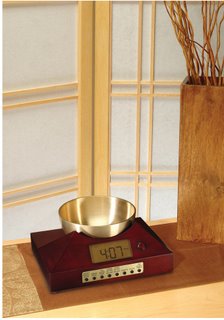 The Zen Timepiece - An acoustic 6-inch brass bowl-gong clock Now & Zen – The Bowl Gong Clock Store
1638 Pearl Street
Boulder, CO 80302
(800) 779-6383
orders@now-zen.com
Posted in sleep, Sleep Habits, wake up alarm clock, Zen Alarm Clock, Zen Timepiece by Now & Zen, Zen Timers
 How to Zazen - Stillness of Being As the name Zen implies, Zen sitting meditation is the core of Zen practice and is called zazen in Japanese. The posture of zazen is seated, with folded legs and hands, and an erect but settled spine.
The legs are folded in one of the standard sitting styles. In many practices, one breathes from the hara (the center of gravity in the belly) and the eyelids are half-lowered, the eyes being neither fully open nor shut so that the practitioner is not distracted by outside objects but at the same time is kept awake.
How to Zazen, a Sitting Mindfulness Practice adapted from wikipedia.org
 Meditation Clock Timer- Zen Timers and Alarm Clocks by Now & Zen Use our unique “Zen Clock” which functions as a Yoga & Meditation Timer. It features a long-resonating acoustic chime that brings your meditation or yoga session to a gradual close, preserving the environment of stillness while also acting as an effective time signal. Our Yoga Timer & Clock can be programmed to chime at the end of the meditation or yoga session or periodically throughout the session as a kind of sonic yantra. The beauty and functionality of the Zen Clock/Timer makes it a meditation tool that can actually help you “make time” for meditation in your life. Bring yourself back to balance.
Now & Zen – The Yoga & Meditation Timer Store
1638 Pearl Street
Boulder, CO 80302
(800) 779-6383
Posted in Chime Alarm Clocks, Japanese Inspired Zen Clocks, Meditation Timers, Meditation Tools, mindfulness practice, Now & Zen Alarm Clocks, Zen Timers
« Previous Page — « Previous Entries
Next Entries » — Next Page »
|
|
|
|